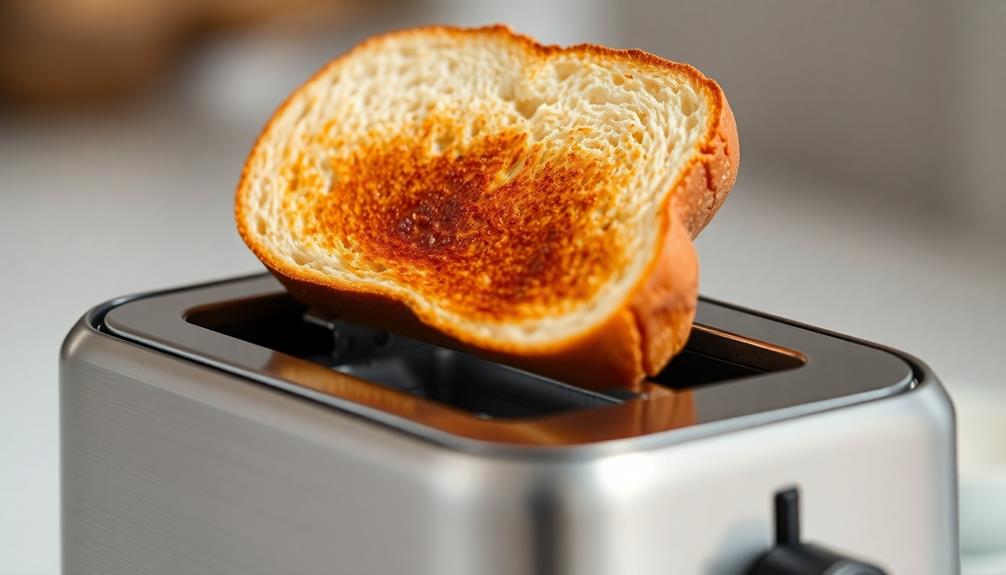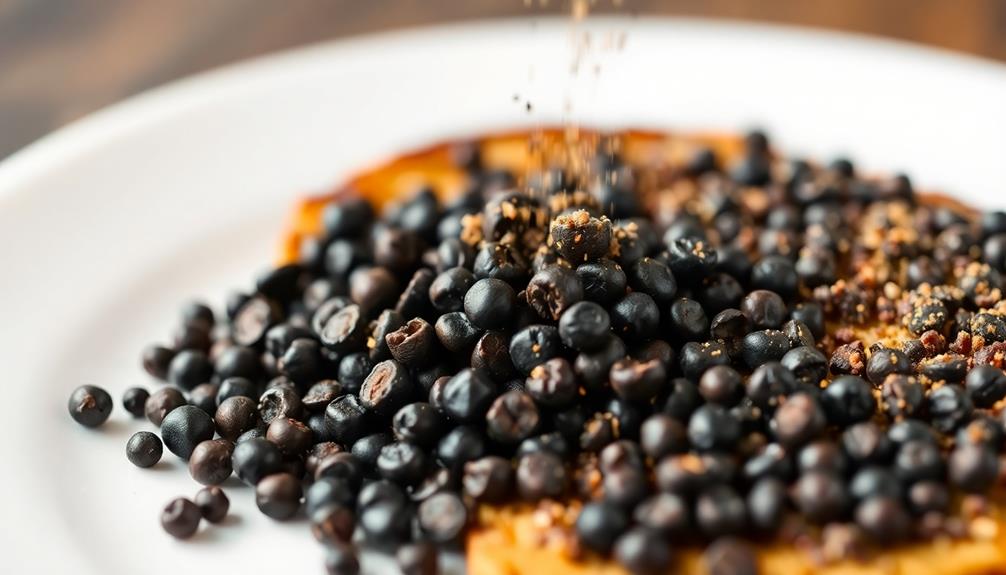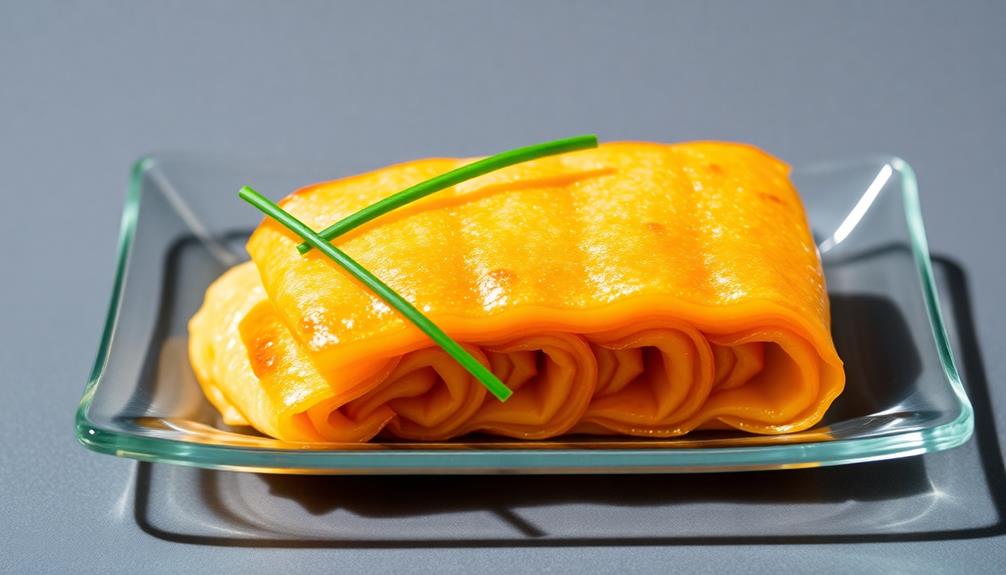You'll love the classic Australian treat of Vegemite on toast! This iconic savory spread was first created in the 1920s and has become a national treasure, connecting generations with its delightfully umami flavor. Simply toast your bread to a golden brown, then spread a thin layer of Vegemite across the surface. For a creamy contrast, add a touch of butter. The salty, rich taste is sure to delight your taste buds. Vegemite is packed with essential B vitamins, making it a nutritious snack. Once you've tried it, you'll understand why Vegemite holds such a special place in the hearts of Australians. There's more to discover about this beloved spread…
Key Takeaways
- Vegemite is a beloved Australian savory spread made from brewer's yeast extract, known for its umami-rich flavor profile.
- The traditional way to enjoy Vegemite is to spread it on toast, often with a thin layer of butter or margarine for creamy contrast.
- Vegemite is rich in essential B vitamins and provides dietary fiber, making it a nutritious and low-calorie option.
- The optimal way to prepare Vegemite on toast is to lightly apply the spread, as it has a strong, concentrated flavor.
- Vegemite has gained global recognition as a unique Australian culinary icon, with variants and fusion recipes emerging worldwide.
History
Dating back to the early 1920s, Vegemite's history is intertwined with the cultural identity of Australia. This beloved spread was created by a young food technologist named Dr. Cyril Callister, who was tasked with finding a use for the leftover brewer's yeast.
After much experimentation, he developed a savory, salty paste that quickly became a breakfast staple across the country. Vegemite's unique flavor, made from concentrated yeast extract, vitamins, and minerals, quickly won over Aussies who couldn't get enough of the dark, almost black spread.
Over the decades, Vegemite has become more than just a food – it's a symbol of national pride. Whether you layer it thickly or spread it thinly, the taste of Vegemite on crispy toast is a true taste of Australia.
From the bustling cities to the remote outback, Vegemite has earned its place as an Aussie icon, connecting generations and creating delicious memories one bite at a time.
Recipe
Vegemite is a savory and umami-rich spread that has become an iconic part of Australian cuisine. When paired with the simplicity of toast, it creates a satisfying and comforting snack that can be enjoyed any time of the day. The key to a perfect Vegemite on toast is to strike the right balance between the robust flavor of the spread and the crisp, golden toast.
The beauty of this dish lies in its simplicity. It's a quick and easy meal that can be prepared in mere minutes, making it the perfect choice for a busy morning, a mid-afternoon pick-me-up, or a late-night indulgence.
Ingredients:
- 2 slices of bread (your preferred type)
- Butter or margarine
- Vegemite
Instructions:
Toast the bread to your desired level of crispness. Spread a thin layer of butter or margarine on each slice of toast. Then, using a small spoon, apply a thin and even layer of Vegemite across the surface of the toast, taking care not to overwhelm the flavors.
When it comes to enjoying Vegemite on toast, it's important to remember that a little goes a long way. The strong, savory taste of Vegemite can be quite intense, so it's best to start with a light hand and gradually increase the amount to suit your personal preferences.
Additionally, some people enjoy a slightly thicker layer of Vegemite, while others prefer a more subtle application. Experiment and find the perfect balance that suits your taste buds.
Cooking Steps
Toast the bread until it's golden brown.
Spread a layer of that iconic Vegemite over the toast, then add a thin smear of cool, creamy butter on top.
Sprinkle on some black pepper if you're feeling fancy – this savory treat is ready to enjoy!
Step 1. Toast the Bread

To begin, grab a slice of bread and place it in the toaster.
Listen closely as the toaster springs to life, heating up the bread and making it crisp and golden. You'll start to smell the delightful aroma of the toasting bread, filling the air with its irresistible scent.
Watch as the bread slowly turns a lovely shade of brown, the perfect canvas for your Vegemite spread.
Once the toast pops up, carefully remove it, being mindful of any lingering heat.
The surface should feel pleasantly firm, with a satisfying crunch when you press on it. If you'd like, you can give the toast a gentle swirl to evenly distribute the heat.
Now it's time to slather on that savory Vegemite, spreading it right to the edges for maximum flavor in every bite.
With the toast perfectly toasted, you're one step closer to enjoying the bold, umami-rich taste of this classic Australian delight.
Step 2. Spread Vegemite Evenly on Toast

With your freshly toasted bread in hand, take a generous dollop of Vegemite and begin spreading it evenly across the surface.
Use the back of a spoon to gently coax the dark, savory spread from the jar, coating the toast in a delightful layer. Smooth it out, making sure to reach the edges so every bite can enjoy the bold, umami flavor.
Don't be shy – Vegemite is meant to be applied liberally! The key is to get an even distribution, creating a consistent texture and taste in each mouthful.
As you work, notice the aroma wafting up, hinting at the deliciousness to come. Keep going until the toast is completely covered, then step back and admire your handiwork.
The Vegemite should glisten invitingly, ready to tantalize your tastebuds. Now, all that's left is to take a big bite and savor the authentic Australian experience!
Step 3. Add a Thin Layer of Butter

After evenly coating the toast with Vegemite, add a thin layer of butter. The cool, creamy butter will complement the bold, salty Vegemite perfectly.
Gently spread the butter from edge to edge using a butter knife. You want just enough to create a light, even coating – not so much that it overwhelms the Vegemite. The contrast of the buttery richness and the savory, umami-packed Vegemite is absolutely divine.
As you press the knife against the toast, you'll hear a satisfying scratch, letting you know the butter is evenly distributed. The golden-brown surface of the toast will glisten with the added butter, making your mouth water in anticipation.
This simple step enhances the Vegemite's flavor and creates a smooth, creamy texture that's truly irresistible. Get ready for a burst of Australian flavor in every bite!
Step 4. Enjoy the Savory Treat

Take a deep breath and savor the intoxicating aroma wafting from the perfectly toasted bread. The dark, glossy spread has been evenly applied, creating a savory canvas for your taste buds.
Gently pick up the slice, feeling the slight warmth radiating through the crust. Bring it close to your face and inhale the bold, umami-rich scent that's uniquely Vegemite.
With eager anticipation, take a small bite, letting the flavors dance on your tongue. The salty, yeasty goodness mingles with the creamy butter, creating a symphony of taste.
Chew slowly, savoring each morsel as it melts in your mouth. The texture is perfectly balanced – not too soft, not too crispy.
As you swallow, feel the satisfying sensation travel down your throat. A smile spreads across your face, and you can't help but take another bite, eager to experience the delightful flavors once more.
Vegemite on toast has never tasted so good.
Step 5. Sprinkle With Black Pepper (Optional)

Your Vegemite-topped toast is the perfect canvas for a light sprinkle of freshly ground black pepper. For an added layer of flavor, you can also drizzle a bit of high-quality olive oil over the toast. This will help enhance the richness of the Vegemite and give a subtle hint of fruitiness to the dish. If you’re feeling adventurous, you could even pair this with a traditional Peking duck recipe for a fusion of Australian and Chinese flavors. The salty umami of the Vegemite would complement the sweet and savory flavors of the duck perfectly.
Just a touch of this fragrant spice can really take your savory treat to the next level! Grab your pepper mill and give it a few twists over the golden toast, letting the tiny black specks dot the surface.
The peppery aroma will instantly awaken your senses, complementing the rich, salty Vegemite flavor. Feel free to sprinkle on as much or as little as you like – a light dusting is often all you need to add a delightful zing.
The contrast of the bold Vegemite and the earthy, warm pepper is simply irresistible. Go ahead, give it a try! You won’t be disappointed by the explosion of flavors in your mouth. If you’re feeling adventurous, you can even try spreading the Vegemite and pepper mixture on a warm piece of toast for breakfast. For a fresh twist, consider making a pesto with alternative herbs to complement the bold flavors.
You'll be surprised by how a simple seasoning can elevate your humble slice of Vegemite toast into something truly extraordinary.
Dig in and enjoy every savory, peppery bite.
Final Thoughts
Ultimately, Vegemite on toast remains an integral part of Australian cuisine and culture.
Whether you're a lifelong Aussie or trying it for the first time, this beloved snack is sure to delight your taste buds. The salty, umami-rich spread pairs perfectly with the crispy, golden bread, creating a delightful contrast in flavors and textures.
As you take that first bite, the aroma of freshly toasted bread and the distinct, savory essence of Vegemite will tantalize your senses.
The creamy, smooth texture of the spread melts in your mouth, leaving a satisfying and comforting sensation.
With each subsequent slice, you'll find yourself falling deeper in love with this quintessential Australian treat.
Frequently Asked Questions
What Is the Origin of Vegemite's Distinctive Flavor?
The unique, umami-rich flavor of Vegemite comes from its high concentration of yeast extract, which is packed with savory compounds like glutamates and nucleotides that stimulate your taste buds, creating that distinctive, love-it-or-hate-it experience.
How Long Can an Opened Jar of Vegemite Be Stored?
Once you've opened a jar of Vegemite, it can be stored in the fridge for up to 6 months. Just be sure to keep it tightly sealed to prevent it from drying out and losing its signature bold flavor.
Can Vegemite Be Used in Recipes Other Than Toast?
Absolutely! Vegemite isn't just for toast. You can use it in all sorts of recipes, from savory baked goods to marinades and dips. Its umami-rich flavor can add depth to many dishes beyond the classic breakfast staple.
Is Vegemite Suitable for Vegetarians and Vegans?
Yes, Vegemite is suitable for vegetarians and vegans. It's a yeast-based spread that doesn't contain any animal products, making it a great option for those following plant-based diets. You can enjoy Vegemite on its own or incorporate it into various dishes.
What Are the Health Benefits of Regularly Consuming Vegemite?
Vegemite is a great source of vitamin B12, which is essential for energy production and red blood cell formation. It also contains folate, iron, and antioxidants that can boost your immune system and overall health when consumed regularly.








